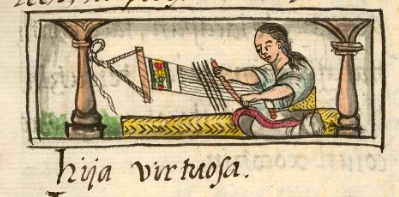iquitihualoni (FCbk10f2r)
This iconographic example, featuring a backstrap loom (iquitihualoni or ihquitihualoni), is included in this digital collection for the purpose of making comparisons with related hieroglyphs. The term selected for this example comes from the keywords chosen by the team behind the Digital Florentine Codex. There is no gloss, per se. This example shows a woman working the loom. As a weaver, she could be a tlamachchiuhqui or a tlatecoa. The loom is tied on the left end to a column (in European architectural style). The other end, a woven belt (neanoni), goes around her back. She kneels on a woven mat (petlatl). She wears a white blouse (huipilli) with a lower red border. She also wears a loose white cotton petticoat with legs (what the Spaniards called naguas). Her hair is long and pulled back loosely behind her neck. She holds onto a wooden weaving batten (tzotzopaztli), which is slid between some of the warp. A part of the fabric she is weaving is visible at the top of the loom: these are red, green, and yellow flowers with a green border above and below. Above that, at the top of the loom is a horizontal board, providing a firm framework for the fabric.
Stephanie Wood
This collection includes examples of the weaving batten, which in one case was raised as a weapon (below). More common are examples of clothing or pieces of cloth, which women made on their looms. None of these have particularly elaborate designs, but the huipilli and the tilmatli could be very fancy pieces.
Stephanie Wood
1577
Jeff Haskett-Wood
tejer, sentar, petate, huipil, cinta de telar, iquiti, iquitqui, tlamachchiuhqui, coser, bordar, mujeres, diseño, tecnología, madera, sogas
iquitihualoni, a loom, https://nahuatl.wired-humanities.org/content/iquitihualoni
el telar
Stephanie Wood
Available at Digital Florentine Codex/Códice Florentino Digital, edited by Kim N. Richter and Alicia Maria Houtrouw, "Book 10: The People", fol. 2r, Getty Research Institute, 2023. https://florentinecodex.getty.edu/en/book/10/folio/2r/images/0 Accessed 1 September 2025.
Images of the digitized Florentine Codex are made available under the following Creative Commons license: CC BY-NC-ND (Attribution-NonCommercial-NoDerivs 4.0 International). For print-publication quality photos, please contact the Biblioteca Medicea Laurenziana ([email protected]). The Library of Congress has also published this manuscript, using the images of the World Digital Library copy. “The Library of Congress is unaware of any copyright or other restrictions in the World Digital Library Collection. Absent any such restrictions, these materials are free to use and reuse.”





